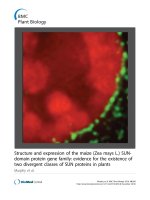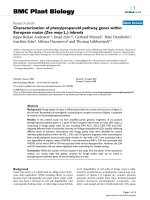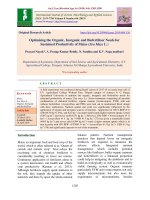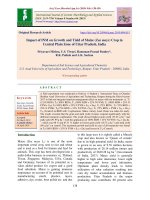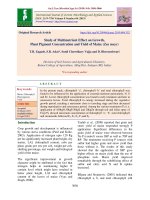Molecular characterization of maize inbred lines against stalk rot complex of maize (Zea mays L.)
Bạn đang xem bản rút gọn của tài liệu. Xem và tải ngay bản đầy đủ của tài liệu tại đây (211.32 KB, 8 trang )
Int.J.Curr.Microbiol.App.Sci (2017) 6(7): 230-237
International Journal of Current Microbiology and Applied Sciences
ISSN: 2319-7706 Volume 6 Number 7 (2017) pp. 230-237
Journal homepage:
Original Research Article
/>
Molecular Characterization of Maize Inbred Lines against
Stalk Rot Complex of Maize (Zea mays L.)
Gopala1, Robin Gogoi1*, Firoz Hossain2, K.S. Hooda3 and J.C. Sekhar4
1
Division of Plant Pathology, 2Division of Genetics, ICAR–Indian Agricultural Research
Institute, New Delhi 110 012, India
3
ICAR-Indian Institute of Maize Research, New Delhi 110 012, India
4
Winter Nursery Centre, ICAR- Indian Institute of Maize Research
Rajendranagar, Hyderabad-500 030, India
*Corresponding author
ABSTRACT
Keywords
Quantitative trait
loci (QTL), Simple
Sequence Repeats
(SSR), Markers,
Screening, Maize
genotypes.
Article Info
Accepted:
04 June 2017
Available Online:
10 July 2017
Stalk rot complex of maize (Zea Mays L.) caused by Macrophomina phaseolina
(Tassi) Goid and Fusarium verticilloides (Sacc) Nirenberg reduces yield directly
by affecting the physiological activity of the plants and finally cause lodging,
which is the main reason of economic losses. Screening of Indian maize inbreds
for the resistance to pathogen was done using 34 Simple Sequence Repeats (SSR)
markers available in database. Among these SSR markers, two markers viz. SSRZ
135, and SSRZ 319 showed polymorphism for resistance to stalk rot. The marker
SSRZ 319 located on chromosome 1 distinguished the resistant lines H 109, P
503, P 408 and E 618 from the susceptible lines viz., H-8, P 320, P 373 and 18834.
Resistant genotypes identified in the study would serve as potential donors in the
stalk rot resistance breeding programme. Further, QTL qRfg2 with most likely
presence in the Indian maize inbred lines can be transferred to elite inbreds using
marker-assisted selection.
Introduction
Macrophomina
phaseolina,
Fusarium
moniliformae and one bacterial Erwinia
carotovora var. zeae (Shankar, 2003). In
India, the disease is prevalent in most of the
maize growing areas viz., Jammu and
Kashmir, Punjab, Haryana, Delhi, Rajasthan,
Madhya Pradesh, Uttar Pradesh, Bihar, West
Bengal, Andhra Pradesh, Tamil Nadu and
Karnataka, where water stress occurs after
flowering stage of the crop (Singh et al.,
2012). PFSR is basically a soil borne disease
for which fungicidal control of stalk rot is not
much effective. Hence, discovery and
Stalk rot is a major disease of maize causing
appreciable damage to the standing crop and
may infect all types of corn (Renfro and
Ullastrup, 1976). According to Sharma et al.,
(1993), maize production in India is severely
limited due to the incidence of a soil borne
disease commonly called Post- flowering
stalk rot (PFSR).
Apart from grain yield, PFSR reduces the
fodder quality. The disease is caused by
pathogen complex comprising three fungi,
viz.,
Cephalosporium
acremonium,
230
Int.J.Curr.Microbiol.App.Sci (2017) 6(7): 230-237
utilization of resistance genes to improve
maize tolerance to stalk rot is a cost effective
and environment friendly approach to reduce
the grain yield loss (White, 1999). Through the
extensive research done at Directorate of
Maize Research, sources of resistance against
the PFSR of maize have been identified
(Kumar and Shekhar, 2005; Sekhar et al.,
2010; Hooda et al., 2012). Parallelly, a large
number of efforts are being diverted towards
development of biotechnological tools for
identification and tagging of genes conferring
resistance to PFSR. For Fusarium stalk rot
resistance a major gene (Yang et al., 2004) and
five QTL (Pe et al., 1993) have been reported
on the different chromosomes. Yang et al.,
(2010) detected two loci QTLS qrfg1 and qrfg
2, conferring resistance to Fusarium stalk rot.
There are four genomic regions exist in the
maize genome involved in the determination of
resistance to M. phaseolina. In contrast to this
progress, study on the genetics of resistance to
charcoal rot or PFSR complex under Indian
scenario is lagging behind and also
information like molecular markers linked to
stalk rot resistance, genetic diversity in maize
inbreds related to PFSR complex have not
been generated. Owing to this reason, present
study was conducted for molecular
characterization of some important Indian
maize inbred lines with respect to the PFSR
complex resistance.
were raised in field during kharif, 2013
following all agronomic practices during the
cropping season. Plants of 45-50 days old were
inoculated by the toothpick method (Payak,
1985) just after flowering. Disease scoring was
done at the time of harvesting in field on a 1-9
scale (Payak and Sharma, 1983).
Molecular characterization of the genotypes
with specific markers
Leaf sampling
Leaf samples were collected from ~30-days
old field grown plants (3-4 leaf stage),
wrapped in marked aluminium foil and then
frozen in LN2 before storing in -80°C.
DNA
isolation,
quantification
purification
and
Screening of maize genotypes in field
DNA isolation from the leaf samples was
carried out using the modified CTAB method
(Saghai-Maroof et al., 1984) optimized at
Maize Genetics Unit, Division of Genetics,
IARI. The DNA was dissolved in Tris-EDTA
buffer (1 M Tris: 0.5 M EDTA) and quantified
using
a
Spectrophotomer
(Bio-Tek
Instruments, USA). The quality of DNA was
checked
using
0.8%
agarose
gel
electrophoresis, followed by dilution with TrisEDTA buffer to the concentration 10 ng/µl, the
final concentration for PCR reaction. DNA
quantification was also done directly by
loading 1µl of DNA in Nanodrop
spectrophotometer (Thermo Scientific Model).
Preparation of inoculum
PCR amplification
Isolation of F. verticilloides from the infected
maize plants and preparation of inoculum from
its pure cultures in PDA.
A set of 30 SSR (Simple Sequence Repeat)
markers (Table 1, Sl. No. 1-30) were selected
carefully from all 10 chromosomes depicted in
public
domain
MaizeGDB;
. Another four SSR
(Sl. No. 31-34) and two CAPS (Sl. No. 35-36)
markers were taken from R gene specific
marker reported by Zhang et al., (2012). Using
Materials and Methods
Raising and screening of genotypes
Twenty four maize genotypes collected from
Winter Nursery Centre (WNC), Hyderabad
231
Int.J.Curr.Microbiol.App.Sci (2017) 6(7): 230-237
all the 34 markers, PCR amplifications were
performed in a BIORAD Thermal Cycler with
a final reaction volume of 10 μl having ~30-40
ng of genomic DNA.
highly susceptible (Table 2). Majority of the
lines namely H-62, BML-6, H-139, 14933-2,
14933-1, H 75, H 37, H 68, 14982-5, 18527
and 18768 were found to be moderately
resistant and seven lines namely H-61, H10,
DMSC-I, H 182, H 103, P 364 and E 613 were
moderately susceptible.
The protocol for the PCR amplification
consisted of an initial denaturation at 94°C for
4 min, followed by about 35 cycles of 94°C for
30 sec (denaturation), X°C for 30 sec
(annealing), and 72°C for 45 sec followed by
extension at 72°C for 7 min. The X°C refers to
the annealing temperature which varied
(ranging from 52- 62°C) with each primer.
Molecular characterization of maize inbred
lines for stalk rot resistance
Out of the 34 SSR markers used for
characterization of maize genotypes, 32
yielded monomorphic band across 24
genotypes. CAPS markers viz., CAPSZ406 and
CAPSZ459 also showed monomorphic band in
all the genotypes. Two SSR markers flanking
the QTL qRfg2 viz., SSRZ135 and SSRZ319
located at physical position of 227.4 Mb and
261.65 Mb, respectively on chromosome 1
showed polymorphism among the 24
germplasm used in the current study. The
marker SSRZ135 showed two allele of 180bp
and 200bp size (Fig. 1), whereas 160bp and
150bp alleles could be resolved by using the
marker SSRZ319. The marker SSRZ319
distinguished all the four stalk rot resistant
genotypes viz., H 109, P 503, P 408 and E 618
each of them possessing 150bp allele (Fig. 2),
while susceptible genotypes viz., H-8, P 320, P
373 and 18834 possessed 160bp allele (Table
3). Although the other marker SSRZ135
revealed polymorphic bands, but it failed to
distinguish between the resistant and
susceptible inbred lines. Fusarium stalk rot is
one of the devastating diseases of Maize in
India. Therefore, understanding the genetics of
the resistance is of utmost importance in order
to develop high yielding disease resistance
maize varieties. Of the several Fusarium stalk
rot resistant QTLs identified, the QTL qRfg2
located on chromosome 1 explaining the
phenotypic variance of ~8.9% has been
identified in resistant maize inbred line „1145‟
(Zhang et al., 2012). The QTL qRfg2 is
flanked by the markers SSRZ319 and
SSRZ135.
Resolution of PCR amplified products and
scoring of marker profiles
The PCR amplified product for each SSR
marker
was
resolved
through
gel
electrophoresis in a horizontal gel system using
1.0X TBE buffer (Sambrook et al., 1989).
Ethidium bromide (10 mg/ml) was used for
staining, 4% Biorose agarose gel was used. At
both ends of the gel, 50 bp DNA ladder (MBIFermentas) was loaded and images were
recorded using a Gel Documentation System
(Alpha Innotech, USA), followed by scoring of
marker profiles.
Results and Discussion
Phenotyping of maize inbred lines for
resistance to stalk rot
In order to characterize the maize inbred lines
for resistance to Fusarium stalk rot, a set of 24
maize inbred lines viz., H-8, H-62, H-61,
BML-6, H-139, 14933, H109, H10, P503,
H75, P320, H182, H103, P408, H37, P364,
H68, 14982, E613, P373, E618, 18527, 18768
and 18834 were used in the current study. The
inbred lines were evaluated under artificial
epiphytotic condition created by toothpick
method of inoculation. Among the inbred lines
studied, four inbred lines H 109, P 503, P 408
and E 618 were found to be resistant and H-8,
P 320, P 373 and 18834 were found to be
232
Int.J.Curr.Microbiol.App.Sci (2017) 6(7): 230-237
Table.1 List of primers used for molecular characterization maize inbred lines
S. No.
1
2
3
4
5
6
7
8
9
10
11
12
13
14
15
16
17
18
19
20
21
22
23
24
25
26
27
28
29
30
31
32
33
34
35
36
Markers
umc1335
umc1280
umc1590
umc1035
umc1245
mmc0041
umc1396
umc1358
umc1570
umc1571
STS
HM1
umc1920
umc2000
umc1634
umc1505
umc1813
umc1926
umc1142
umc1656
y1
umc56
phi091
umc1245
bmc1556
umc1947
umc1943
bnlg1931
bnlg2244
bnlg1456
SSRZ135
SSR334
SSRZ319
SSR58
CAPSZ459
CAPSZ406
FORWARD PRIMER
ATGGCATGCATGTGTTTGTTTTAC
AAAATCCATGGCTTCTTTCTTTCC
CAGAGTCTGATAGTCCGAACCCAG
CTGGCATGATCACGCTATGTATG
TGGTTATGTGCATGATTTTTCCTG
AGGACTTAGAGAGGAAACGAA
TTCGATTATTCCATTGAGCCTCTG
AGAACCTCCCGCTTGACGAC
CAGGAGATGATGAGCGGGAG
GCACTTCATAACCTCTCTGCAGGT
CGCAATTCACCACATCATTTTA
CGGATTCGTCTGCTGGTGGGTGTGC
GGTTCGGGTTTGCTACGTGTT
CTGTTGTCAAGCCAAGCCAGT
TCCGTTGAGGACACTCGAATTTAT
TTACACAGAAGCCCATTTGAAGGT
CTGTACATGGATATGGCATTGGTG
ATGCCAGCATTCTTCATCCTACAT
CCGAAAACCCATTCTTCTAGCATC
AGTTTTGACCGCGCAAAAGTTA
CAAGAAGAGGAGAGGCCGGA
CAACTCATCTTTGATAGGGCAACC
ATCTTGCTTCCATAAGATGCACTGCTCT
TGGTTATGTGCATGATTTTTCCTG
ACCGACCTAAGCTATGGGCT
GGATCTCACCCCCTGCTGTC
GTGCTGCAGAATTCAACTCCTTC
GGGATGCTCGTAGTAGGGGT
CAGGAAAACGAAAACCCAGA
CTCTAGGTGGTTAAGATTAACTCATT
CCGATCCTCCTCCTTCAG
TTCGAGCATGCCAAAGAA
CACCTTCCTCTTGCTGTC
GACGCTGCACAATAGGTT
GCAATCGGAATTTAGGG
GATACATGCACAGAAG
233
REVERSE PRIMER
ACAGACGTCGCTAATTCCTGAAAG
AACAGCCAGTTTTGGGCTGTATAA
GTAAAGCTCACAGCTTCCGACAG
TAACATCAGCAGGTTTGCTCATTC
CATGCGTCTGATCTTCAGAATGTT
TTTATCCTTACTTGCAGTTGC
CTCCTAACGCAGGAGACAAGAGAG
ACCTCAACCTCGACCTCTGCAT
GTCGTAGAGGTGGTGCTGCTG
CACCGAGGAGCACGACAGTATTAT
CAACTACGTCGGATAGAACAA
GATGTCGAGGTGAGGGAAC
ACGAGACAACACAACCAAGACAAA
AGGCTTGTGAGACTCAGCAGTTTT
GTAGCCTGCAAAACATCCAAGAAC
GGATGGTTGTTGGTGGTGTAGAAT
GCATATACACCACCTTGGACAACA
TGAGGCTTGGTCCACTAAAGAAAG
GTGCGGTGTTCTCTCTTTCACTCT
GTACGAGCAGGCCATTAACCC
TTGAGCAGGGTGGAGCACTG
ACCCAGCTCCATTAATAACCCAAT
CTCAGCTTCGGTTCCTACACAGT
CATGCGTCTGATCTTCAGAATGTT
CCGGTTATAAACACAGCCGT
ATCACGCGCTCACTCTCCTCT
ACCATTTCTGCGTTTCCACAGT
ACGCACACAACAAAGAGACG
CTACGCGGGTCTCATCTCAT
TTCATGAGGACCGTGTTGAA
CTGACGTAGTGCTGCGA
GGTGCACACAGACATGG
CTGCACCTGCTAGTCCTG
TCATTATACACCGACGACC
GCATAACTCGGCTGGCAT
GTCCATTGTCACCACTGA
Location
1.06
10.05
1.04
1.06
1.07
1.08
1.06
1.07
9.04
9.04
3.04
9.03
9.08
3.09
4.03
4.05
6.02
6.01
7.03
7.03
1.07
1.07
2.08
4.02
3.07
4.08
3.05
1.09
1.09
-
Int.J.Curr.Microbiol.App.Sci (2017) 6(7): 230-237
Table.2 Markers, location on chromosome and their amplification
S. No.
1
2
3
4
5
6
7
8
9
10
11
12
13
14
15
16
17
18
19
20
21
22
23
24
25
26
27
28
29
30
31
32
33
34
35
36
Markers
umc1335
umc1280
umc1590
umc1035
umc1245
mmc0041
umc1396
umc1358
umc1570
umc1571
STS
HM1
umc1920
umc2000
umc1634
umc1505
umc1813
umc1926
umc1142
umc1656
y1
umc56
phi091
umc1245
bmc1556
umc1947
umc1943
bnlg1931
bnlg2244
bnlg1456
SSRZ135
SSR334
SSR319
SSR58
CAPSZ459
CAPSZ406
Bin Location
1.06
10.05
1.04
1.06
1.07
1.08
1.06
1.07
9.04
9.04
3.04
9.03
9.08
3.09
4.03
4.05
6.02
6.01
7.03
7.03
1.07
1.07
2.08
4.02
3.07
4.08
3.05
1.09
1.09
234
Allelic Polymorphic
Monomorphic
Monomorphic
Monomorphic
Monomorphic
Monomorphic
Monomorphic
Monomorphic
Monomorphic
Monomorphic
Monomorphic
Monomorphic
Monomorphic
Monomorphic
Monomorphic
Monomorphic
Monomorphic
Monomorphic
Monomorphic
Monomorphic
Monomorphic
Monomorphic
Monomorphic
Monomorphic
Monomorphic
Monomorphic
Monomorphic
Monomorphic
Monomorphic
Monomorphic
Monomorphic
Polymorphism
Monomorphism
Polymorphism
Monomorphism
Monomorphism
Monomorphism
Int.J.Curr.Microbiol.App.Sci (2017) 6(7): 230-237
Table.3 Genotypic score of 24 maize inbred line generated using markers linked to
Fusarium stalk resistance QTL qRfg2
Lane
No.
2
4
5
6
11
16
18
19
20
24
3
8
13
14
17
23
7
9
15
22
1
12
21
10
Inbreds
Primer (SSRZ 135)
Primer (SSRZ319)
Reaction
H-62
BML-6
H-139
14933
H 75
H 37
H 68
14982,-5
18527
18768
H-61
H 10
H 182
H 103
P 364
E 613
H 109
P 503
P 408
E 618
H-8
P 320
P 373
18834
180
200
200
200
180
200
180
200
200
200
NA
180
180
NA
180
200
200
180
200
200
200
200
200
200
150
NA
150
160
150
160
160
150
160
150
160
160
150
150
150
150
150
150
160
150
160
160
150
160
MR
MR
MR
MR
MR
MR
MR
MR
MR
MR
MS
MS
MS
MS
MS
MS
R
R
R
R
S
S
S
S
NA: Not amplified
In the present study, SSRZ319 was efficient
in distinguishing the resistant and susceptible
maize inbred lines. This suggests that Indian
maize inbred lines that plays role in governing
resistance to Fusarium stalk rot in maize, is
most likely to possess QTL qRfg2. However,
the other flanking marker SSRZ135 could not
distinguish the resistant and susceptible maize
inbred lines. This could be attributed to usage
of different sets of genotypes (used in the
present study), where distance between the
QTL and markers is more (Zhang et al.,
2012). Due to this, the possibility of high
occurrence of recombination between the
gene and the marker would be more, thereby
leading to random presence of both the alleles
among resistant and susceptible inbreds.
The present study, thus characterized a set of
diverse inbreds for their reaction to Fusarium
stalk rot. Resistant genotypes identified in the
study would serve as donors in the resistance
breeding programme. QTL qRfg2 with most
likely presence in the resistant inbreds can be
235
Int.J.Curr.Microbiol.App.Sci (2017) 6(7): 230-237
transferred to elite inbreds using markerassisted selection. Breeding with the
assistance of molecular marker have been
reported to be successful in case of
developing resistance against different
stresses in maize such as common smut (Ding
et al., 2008), head smut (Li et al., 2008),
Fusarium moniliforme ear rot (Zhang et al.,
2006), banded leaf and sheath blight (BLSB)
(Zhao et al., 2006), Maize Dwarf Mosaic
Virus (MDMV) disease (Liu et al., 2006) and
Sugarcane Mosaic Virus (SCMV) disease
(Zhang et al., 2003)
Liu, X., He, D., Zhang, H. 2006. QTL
mapping for resistance to MDMV2B in
maize. J. Agric. Univ. Hebei 29:56–59.
Payak, M.M., Sharma, R.C. 1983. Influence
of some environmental and host factors
on Pythium stalk rot of maize. Indian
Phytopath. 33: 10-15.
Payak, M.M., Sharma, R.C. 1985. Maize
diseases and approaches to their
management in India. Trop. Pest.
Manag. 31: 302-310
Pe, M. E., Gianfranceschi, L., Taramino, G.,
Tarchini, R., Angelini, P., Dani, D.
Binelli, G. 1993. Mapping quantitative
trait loci QTLs for resistance to
Gibberella zeae infection in maize. Mol.
Gen. Genet. 241: 11-16.
Renfro, B. L Ullstrup, A.J. 1976. A
comparison of maize diseases in
temperate and tropical environments.
PANS 22:491-498.
Shankar Lingam, S. 2003. Maize diseases and
their management. In: Manual on
“Issues in Hybrid maize Technology”,
ANGRAU-DMR (ICAR) publication
42: 66-73.
Sharma, R.C., Carlos, D. L., Payak, M.M.
1993. Diseases of maize in South and
South East Asia: problems and progress
crop protection 12: 414-422.
Singh, N., Rajendran A., Meena, S. and
Mittal, G. 2012. Biochemical response
and host-pathogen relation of stalk rot
fungi in early stages of maize (Zea mays
L.) African J. Biotech. 11(82): 1483714843.
White, D. G. 1999. Fungal stalk rots.
Compendium of Corn Diseases
3rd Edition. (Ed. D. G. White). APS
Press. St. Paul, MN.
Yang, D. E., Zhang, C. L., Zhang, D.S, Jin,
D.M., Weng, M. L., Chen, S.T. Nguven,
H.2004. Genetic analysis and molecular
mapping of maize stalk rot resistance
gene Rfg1. Theor. Appl. Genet. 108:4
706-711.
Acknowledgement
Authors are thankful to the Indian Council of
Agricultural Research providing fellowship
for pursuing M.Sc., programme and also
thankful to the winter nursery center (Indian
Institute of Maize Research), Rajendranagar,
Hyderbad for providing maize inbred lines.
References
Ding, J.Q., Wang, X.M., Chander, S., Li, J.S.
2008. Identification of QTL for maize
resistance to common smut by using
recombinant inbred lines developed
from the Chinese hybrid Yuyu22.
J.Appl.Genet.49:147-154.
Hooda, K. S. 2012. Identifying sources of
multiple disease resistance in maize.
Maize J. 1(1):82-84.
Kumar, S., Shekhar, M. 2005. Stress on
Maize in Tropics Eds. Published by
Directorate of Maize Research,
Cummings Laboratory, Pusa Campus,
New Delhi. Angkor Publisher (P) Ltd.
Noida. 172- 194.
Li, X.H.,Wang, Z.H., Gao, S.H., Shi, H.L.,
Zhang, S.H.,George,M.L.C., Li,M.S.,
Xie. C.X. (2008) Analysis of QTL for
resistance to head smut (Sporisorium
reiliana) in maize. Field Crops Res.
106:148–155
236
Int.J.Curr.Microbiol.App.Sci (2017) 6(7): 230-237
Yang, Q., Yin, G., Guo, Y., Zhang, D., Chen,
S. Mingliang, Xu. M. 2010. A major
QTL for resistance to Gibberella stalk
rot in maize. Theor. Appl. Genet. 121:
673-87.
Zhang, F., Wan, X. Q., Pan, G. T. 2006. QTL
mapping of Fusarium moniliforme ear
rot resistance in maize. 1. Map
construction with microsatellite and
AFLP
markers.
J.
Appl.
Genet. 47: 9–15
Zhang, S. H., Li, X. H., Wang, Z. H., George,
M. L., Jeffer, D., Wang, F. G., Liu, X.
D., Li, M. S. and Yuan, L. X. 2003.
QTL mapping for resistance to SCMV
in Chinese maize germplasm. Maydica
48:307–312.
Zhao, M. J., Zhang, Z. M, Zhang, S. H., Li,
W. C., Jeffers, D. P, Rong, T. Z. and
Pan, G. T. 2006. Quantitative trait loci
for resistance to banded leaf and sheath
blight in maize. Crop Sci. 46: 1039–
1045.
How to cite this article:
Gopala, Robin Gogoi, Firoz Hossain and Hooda, K.S. 2017. Molecular Characterization of
Maize Inbred Lines against Stalk Rot Complex of Maize (Zea mays L.).
Int.J.Curr.Microbiol.App.Sci. 6(7): 230-237. doi: />
237
